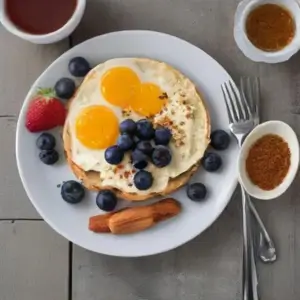Gluten-Free Breakfast Ideas for a Delicious and Healthy Start
Table of Contents
ToggleIntroduction
If you’re avoiding gluten, it’s essential to start your day with meals that are both delicious and safe for your diet. A gluten-free breakfast can be just as satisfying and flavorful as any other. This guide provides a detailed overview of gluten-free breakfast options, answers common questions, and offers tips to help you enjoy variety while avoiding gluten.
Tips
- Batch cook gluten-free breakfast items like frittatas or pancakes for easy grab-and-go meals throughout the week.
- Incorporate protein-rich foods like eggs, nuts, and yogurt to keep you full for longer.
- Try swapping traditional grains like wheat for quinoa or rice to mix up your breakfast routine.
Things to Avoid when making gluten-free breakfast
- Avoid oats unless they are certified gluten-free to prevent accidental gluten consumption.
- Watch out for hidden gluten in processed breakfast meats or sauces.
- Be cautious with baked goods marketed as gluten-free. Some may contain cross-contaminated ingredients unless clearly labeled.
What Can I Eat for Breakfast Without Gluten?
A gluten-free diet eliminates wheat, barley, and rye, but there’s still a wide variety of naturally gluten-free foods to enjoy at breakfast. Here are some options:
1. Eggs: Scrambled, fried, or poached. Add veggies for a nutrient-packed start.
2. Yogurt with Fresh Fruit: Add chia seeds or nuts for texture and protein.
3. Gluten-Free Toast: Use gluten-free bread with avocado, peanut butter, or scrambled eggs.
4. Smoothies: Packed with fruit, vegetables, and gluten-free protein powder.
5. Breakfast Bowl: Combine quinoa, sweet potatoes, and avocado for a savory meal.
Some naturally gluten-free whole grains include rice, quinoa, and corn. Ensure any packaged products have a gluten-free label to avoid cross-contamination.
Is Oatmeal OK for a Gluten-Free Diet?
Oats themselves are naturally gluten-free. However, they are often processed in facilities that handle gluten-containing grains, leading to potential contamination. If you’re gluten-sensitive or have celiac disease, it’s crucial to buy certified gluten-free oats. These oats are processed separately, reducing the risk of contamination.
For a hearty gluten-free breakfast, try oatmeal topped with berries, nuts, and a drizzle of honey. This comforting meal is packed with fiber and can be customized to your taste preferences.
Common Gluten-Free Breakfast Meals
Gluten-Free Pancakes: Made with gluten-free flour, eggs, and milk. Top with syrup or fresh fruit.
Smoothie Bowls: Blend bananas, spinach, almond milk, and top with gluten-free granola.
Frittata: A baked egg dish packed with vegetables, cheese, and herbs.
Chia Pudding: A pudding-like dish made from chia seeds soaked in almond or coconut milk.
These are just a few common gluten-free breakfast options that ensure a satisfying and balanced meal without the worry of gluten contamination.
What Grains and Flours Are Naturally Gluten-Free?
When it comes to gluten-free baking or meal prep, knowing your options is key. Here’s a list of naturally gluten-free grains and flours that you can incorporate into your breakfast routine:
1. Buckwheat: Despite its name, buckwheat is gluten-free. It’s perfect for making hearty gluten-free pancakes or porridge.
2. Almond Flour: Rich in protein and healthy fats, almond flour can be used in baking muffins or pancakes.
3. Coconut Flour: Low-carb and gluten-free, coconut flour is a popular choice for those avoiding both gluten and grains.
4. Quinoa Flour: This versatile flour adds a nutty flavor to your breakfast, great for pancakes or baked goods.
5. Teff: A nutrient-dense ancient grain, teff is excellent for porridge or adding to gluten-free granola mixes.
6. Cornmeal/Polenta: Can be used to make a savory breakfast porridge or as a base for baked goods like muffins or cornbread.
Each of these can be blended into your morning routine, offering a variety of flavors and textures to keep breakfast exciting.
Protein Power: Building a High-Protein Gluten-Free Breakfast
A protein-rich breakfast helps stabilize blood sugar levels and keeps you fuller for longer. Here are some excellent protein sources that are naturally gluten-free:
1. Strained Yogurt: Packed with protein, this can be paired with gluten-free granola, fresh fruit, or chia seeds.
2. Cottage Cheese: Low in carbs and high in protein, add it to gluten-free toast or blend it into smoothies for an extra creamy texture.
3. Nut Butters: Almond, cashew, or peanut butter spread on gluten-free toast or mixed into smoothies gives you a hearty dose of healthy fats and protein.
4. Chia Seeds: A small powerhouse of protein and fiber, chia seeds can be added to smoothies or used to make chia pudding with almond milk.
5. Tofu Scramble: If you’re avoiding eggs or on a plant-based diet, tofu is an excellent alternative. Crumble it and sauté with turmeric and veggies for a protein-packed, gluten-free option.
Common Meals that Are Gluten-Free
- Smoothies: One of the easiest go-to gluten-free breakfasts, smoothies can be packed with fresh fruits, veggies, protein powders (gluten-free certified), and almond milk.
- Shakshuka: A savory dish of poached eggs in a rich, spiced tomato sauce, usually served with gluten-free bread.
- Gluten-Free Granola: Made from gluten-free oats, nuts, seeds, and dried fruits, you can easily whip up a batch and enjoy with yogurt or milk.
- Sweet Potato Hash: Cubed and roasted sweet potatoes, combined with spinach, onions, and eggs, make for a filling and nutritious gluten-free breakfast.
- Rice Pudding: For a warm, comforting start, cook rice with almond milk, a pinch of cinnamon, and a drizzle of honey.
- Egg Muffins: Baked mini frittatas made with veggies and cheese in a muffin tin, these are easy to make ahead for grab-and-go breakfasts.
- Avocado Bowl: A combination of avocado, quinoa, eggs, and cherry tomatoes for a protein-packed, gluten-free meal.
Key Nutritional Aspects of a Gluten-Free Breakfast
1. Fiber: Many gluten-containing products, like whole wheat bread, are good sources of fiber. To maintain fiber intake, incorporate gluten-free whole grains such as quinoa, buckwheat, and flaxseeds.
2. Carbohydrates: Opt for complex carbohydrates from sweet potatoes, bananas, or gluten-free grainsto keep your energy levels up throughout the morning.
3. Healthy Fats: Avocados, nuts, seeds, and olive oil are excellent sources of healthy fats that complement a gluten-free diet.
Quick gluten-free breakfast Ideas for Busy Mornings
If you’re in a rush, these simple, nutrient-dense options can be thrown together quickly:
1. Gluten-Free Instant Oatmeal Packs: Choose certified gluten-free brands and top with berries or nuts.
2. Pre-made Smoothie Bags: Freeze chopped fruits, spinach, and protein powder in portioned bags. Just upload almond milk and mix withinside the morning.
3. Rice Cakes with Nut Butter: Spread almond butter over gluten-free rice cakes and top with banana slices for a quick and filling snack.
Things to Watch Out For in Gluten-Free Breakfast
1. Hidden Gluten: Some pre-made breakfast items, especially processed foods, can contain hidden gluten. Watch out for ingredients like malt, barley, and wheat starch.
2. Cross-Contamination: Make sure to use separate kitchen tools and appliances for gluten-free cooking to avoid contamination, especially when preparing gluten-free toast.
3. Processed Gluten-Free Foods: While convenient, some gluten-free packaged products may be high in sugars or fats to make up for texture. Stick to whole, unprocessed foods when possible.

Gluten Free Breakfast
Equipment
- Frying pan
- Toaster (specifically for gluten-free bread to avoid cross-contamination)
- Blender (for smoothies)
- Mixing Bowls
- Measuring cups
Ingredients
- 4 large eggs
- 1 cup certified gluten-free oats
- 1 medium avocado
- 1 tbsp chia seeds
- 1 cup fresh berries
- 2 slices of gluten-free bread
- 1 tbsp honey
Instructions
- Gluten-Free Toast & Avocado: Toast the gluten-free bread in a separate toaster or on a pan. Mash avocado with a pinch of salt and pepper, and spread over the toast.
- Egg Scramble: In a frying pan, scramble eggs with a splash of milk, and add spinach or tomatoes for a boost of nutrients. Serve alongside gluten-free toast.
- Oatmeal: Cook gluten-free oats according to package instructions. Top with berries, chia seeds, and honey for a naturally sweet, fiber-rich breakfast.
Still hungry? Check-out these recipes:








2 thoughts on “Best gluten-free Breakfast full guide”